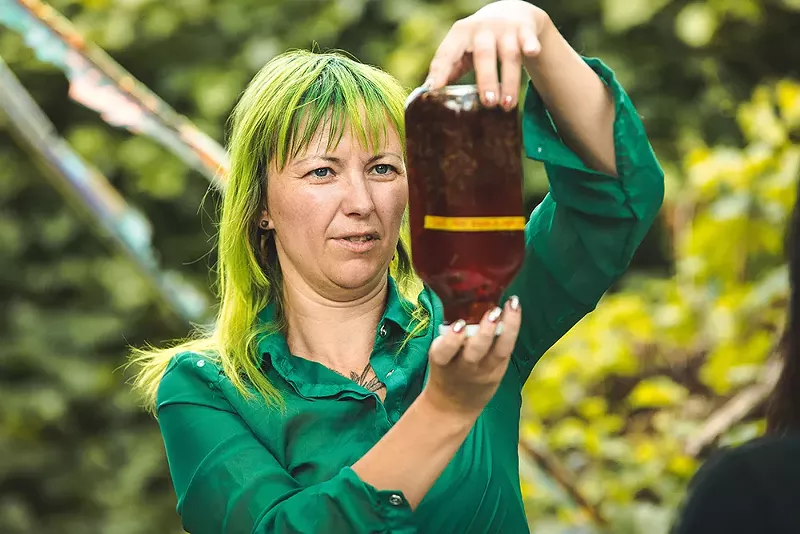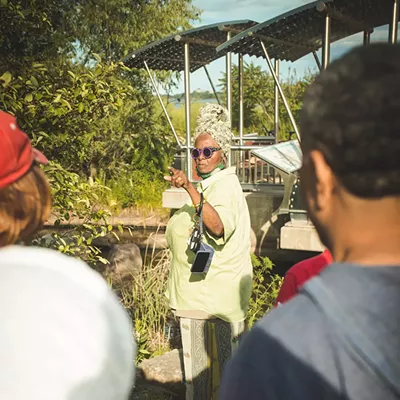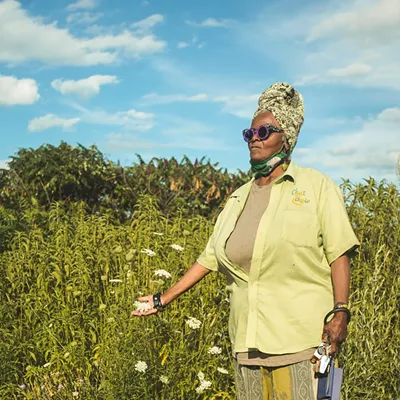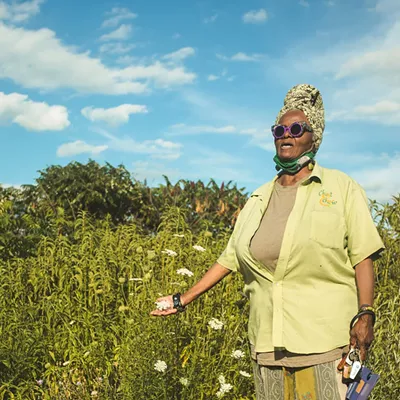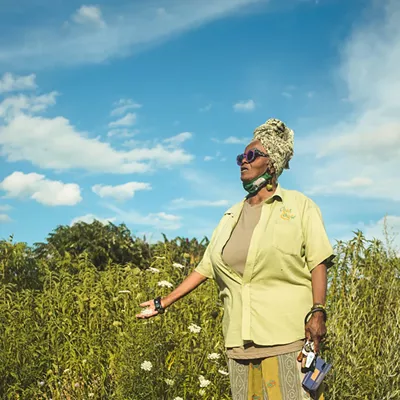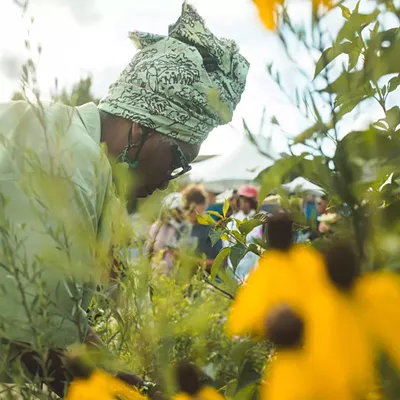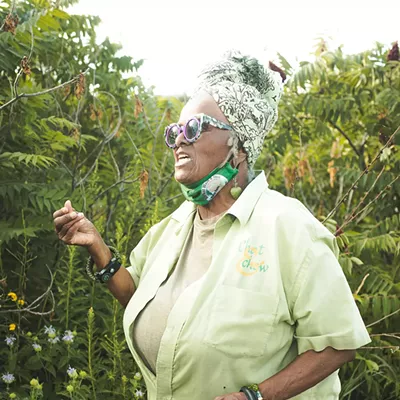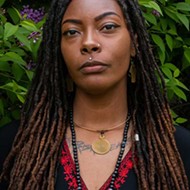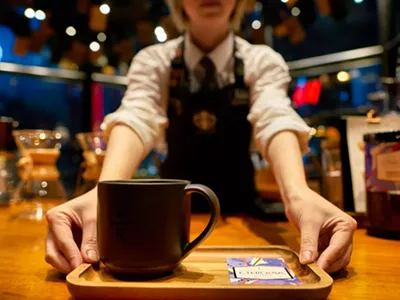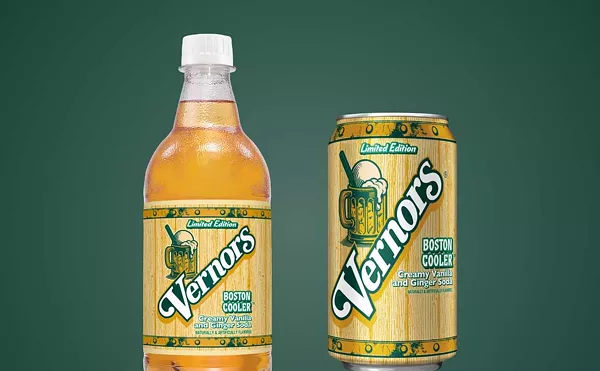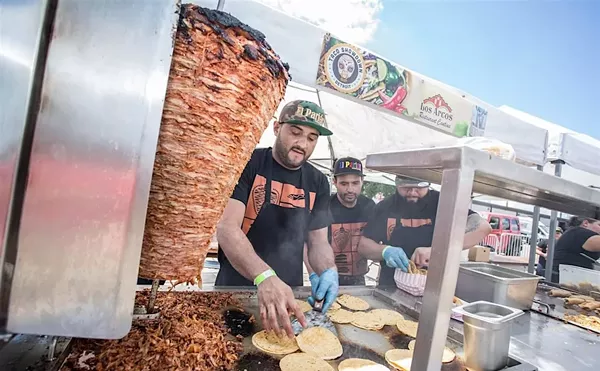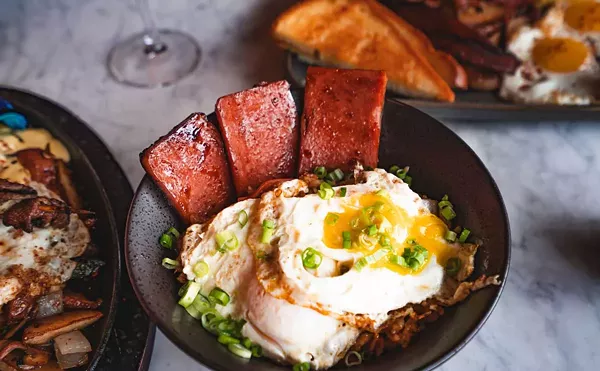Why Detroiters are turning to herbalism and eating common weeds that grow in their backyards
Weedeaters: ‘When you eat wild foods, you have wild thoughts and it’s truly revolutionary’

Audio By Carbonatix
[
{
"name": "GPT - Leaderboard - Inline - Content",
"component": "35519556",
"insertPoint": "5th",
"startingPoint": "3",
"requiredCountToDisplay": "3",
"maxInsertions": 100,
"adList": [
{
"adPreset": "LeaderboardInline"
}
]
}
]
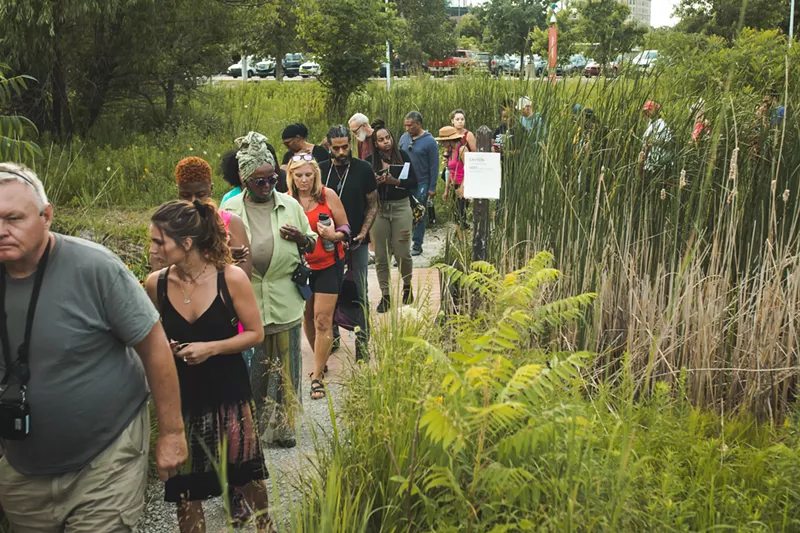
On a sunny Monday evening, Mama Ravin takes participants along the Detroit Riverwalk to find edible wild plants.
Fascination and wonder spread across the group as Ravin points out a spindly white flower forming a curly cluster of buds that she identifies as wild carrot, or Queen Anne’s lace.
Queen Anne’s lace (Daucus carota) is an invasive weed, but its roots and flowers are edible. Some people say the roots have a taste similar to carrots, hence the common name.
You’ve likely seen Queen Anne’s lace growing in parks, roadsides, empty lots, and, perhaps, even your own backyard.
Mama Ravin, whose real name is Regina Lawson, has been hosting her “Herbal Walk & Talk” in partnership with the Detroit Riverfront Conservancy for the past decade. The “chat and chew” stroll takes participants through Milliken State Park, stopping to identify edible herbs and learn their culinary and medicinal properties along the way.
A bushy bundle of berries provides a pop of deep red against a sea of green plants. This one is sumac, which many people know as the spice commonly used in Mediterranean za’atar seasoning. Turns out it’s not some distant, foreign ingredient. It’s growing undisturbed on the Riverwalk, though technically you’re not supposed to pick anything growing here. The berries can also be used to make lemonade.
Mama Ravin is an elder in the local herbalist community who uses plants as both food and medicine. At 73 years old, she claims the healing properties of plants have kept her from getting a cold or the flu since her early 20s. She’s also vegan and has been incorporating backyard weeds into her everyday cooking pretty much her entire life.
Of course, herbal medicine isn’t new. It’s been used by indigenous cultures around the world for thousands of years. Herbalists use plant-based teas, tinctures, salves, and other concoctions to treat inflammation, anxiety, heart conditions, and everything in between. As more people turn to plant-based diets to heal themselves and the planet, it isn’t surprising that people are exploring alternative healing modalities involving plants and other natural substances, whether it’s psilocybin, marijuana, or herbs.
Carmen Malis King, co-founder of Healing by Choice, says herbalism’s recent rise in popularity may be due to both the COVID-19 pandemic, which caused people to look more closely at their health, and the desire to decolonize medicine.
“People, in general, are reclaiming and reconnecting with ancestral and cultural healing ways,” King says. “The language that really took off about 10 years ago within Indigenous ideas about deconstructing this mindset based on colonial imperialism and white supremacy maybe had some influence there. Unpacking that had an influence of some people thinking about how to undo what we think of as normal.”
Back on the Riverwalk, Mama Ravin tells us she’s always lived a plant-based lifestyle, even though her parents disapproved.
“People, in general, are reclaiming and reconnecting with ancestral and cultural healing ways,” King says.
tweet this
“I’ve never swallowed meat,” she boasts. “It was put in my mouth when I was a child, but I would spit it out and my mother beat my behind every time. But I was determined to stick to my guns and just be the person I wanted to be. I didn’t wanna swallow no meat. I just wasn’t going to do it, so I just took that behind whooping every single time. I would just give her the switch and say, just do what you gotta do, mom.”
She says the secret to her health all these years is not just veganism, but dandelions in particular.
Yes, dandelions — that annoying plant sprouting through the cracks in the sidewalk and colonizing front lawns that most people are more interested in killing than eating.
At 5 years old, Ravin remembers her grandmother would make collard greens to feed her family of 19. To stretch the greens and keep costs low, her grandmother added dandelion leaves, a secret ingredient which only Ravin knew about.
“And those greens were good every Sunday,” Ravin says. “So my passion for this dandelion has been with me all my life and I’ve been preaching about these dandelions forever. I used to tell people in the neighborhood, would you stop cutting down dandelions because the whole plant is edible, which nobody knew. But me and my grandmother knew.”
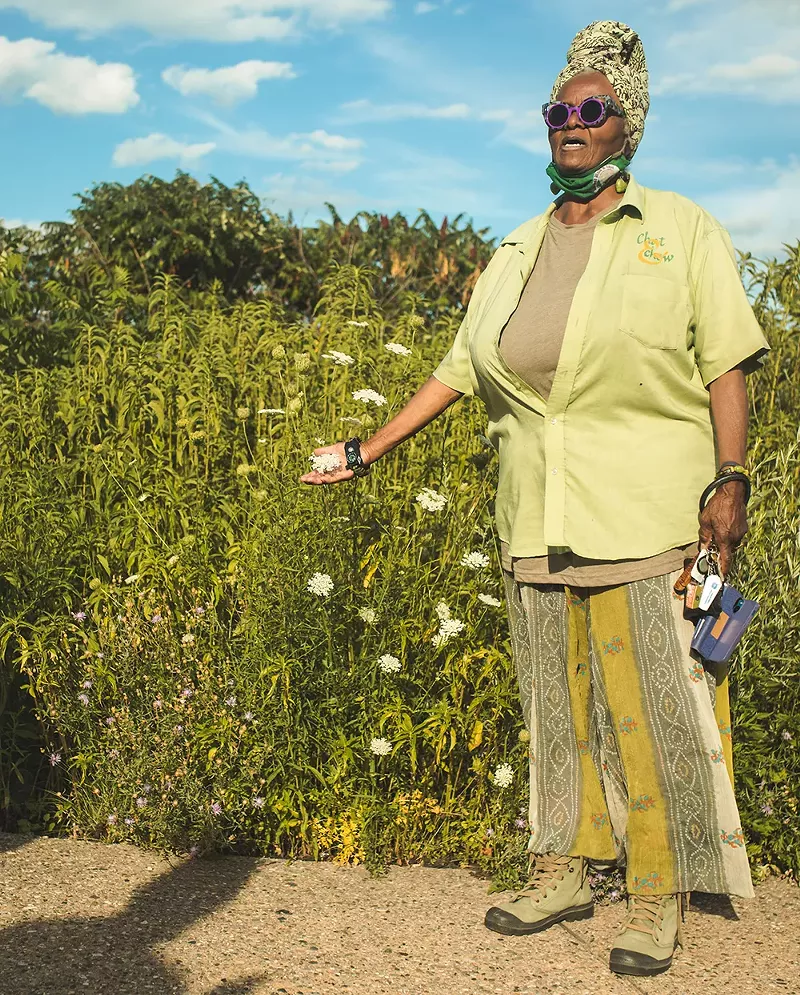
Mama Ravin and her grandmother may have been onto something. Beyond being abundant and free, dandelion greens are highly nutritious. The toothed leaves of the yellow flower are said to have two times more calcium, three times more Vitamin A, and eight times more antioxidants than spinach.
We don’t find any dandelions on the Riverwalk during our trip, but we do find several other plants that can be eaten in everyday cooking and survival situations. Another invasive weed known as the common broadleaf plantain (no, not the banana), has edible leaves and seeds that are thought to help with inflammation and digestive problems. There’s also milkweed and cattail, which Mama Ravin says can be used to make pancakes.
Before she was teaching people about plants on the Riverwalk, Mama Ravin was simply known as “the weed lady.” People getting their daily exercise on the Detroit river strip would always point out the strange, elderly woman picking weeds, wondering what exactly she was doing. That’s how she got discovered by the Michigan Department of Natural Resources.
“I was doing what I’m doing, minding my own business and they would say, ‘There go the weed lady,’” she remembers. “The Department of Natural Resources heard about it and they said we gotta talk to this lady because they put all these beautiful [plants] out here but they didn’t know what they had here actually. So people said, get the weed lady over here and she’ll tell you.”
She adds that initially, she thought “the weed lady” was somebody who was selling marijuana (which she emphasizes she has never even smoked), but eventually the name stuck.
Through her business, The Herbal Healing Hut, Mama Ravin has worked with groups like the DNR, Detroit Riverfront Conservancy, Detroit Outdoors, and others to preserve and share what she calls “herbal medicinal and dietary traditions of our Aboriginal ancestors.” She founded The Herbal Healing Hut in 1997 and offers everything from herb walks, cooking classes, dietary consultations, and reflexology. The herb walks are the most popular, and are followed up by a vegan meal prepared by Ravin.
This time she serves participants indigenous rice with lentils, a melody of hazelnuts, almonds, and walnuts, and a pasta salad loaded with vegetables — including dandelion, of course.
Ravin hasn’t had any formal training in herbal medicine. Instead, she says, the lifestyle she’s been living since childhood has been her greatest teacher.
“I haven’t taken any medicine since I was maybe 27. It’s because the food is my medicine,” she says. “If you don’t eat the right food, you’re not gonna do any healing. Anything that was here before us, is here to help us. It was hard coming up in my family, talking about healing and trying to get them to go and eat food from the backyard, but I’m happy that now people are catching on and are open to it.”

Ushering in the new school
Flowers grow wild in a Hamtramck backyard as a neon-green-haired woman dressed in rainbow pants leads us through a plant meditation on the grass.
We connect with the Earth, breathing in the oxygen from the nearby plants. As we exhale, the flora breathe in, and as we inhale, the life blooming around us breathes out. Or at least, that’s what Zarah Ackerwoman — the green-haired lady running the plant medicine workshop — tells us, anyway.
We pick a budding St. John’s wort (Hypericum perforatum), the plant we’ve come to learn about today, and look for any special characteristics before putting the flower in our mouths to create a sensory connection.
Ackerwoman started the Detroit chapter of Herbalists Without Borders (HWB), a worldwide collective of herbal medicine practitioners, in the summer of 2020 in response to the Black Lives Matter movement.
“[It was] a political action to give back to and create community around healing and self-care,” she says. “I look at it through the anarchist lense. Defund the police, make your own medicine, take your power back from the medical system and big pharma.”
HWB Detroit promotes herbal education and accessible “health justice” through a series of skillshares, herb walks, and medicine-making workshops. Eventually, the group plans to install Little Free Medicine cabinets around the city, similar to Little Free Libraries that offer books, instead stocked with herbal medicine made by the community.
After listening for any messages from the bright yellow flower, Ackerwoman gives us the option to eat it, which we do. It tastes like sunshine. Like a warm and joyous yellow rainbow.
Hypericum perforatum (Ackerwoman prefers to call plants by their botanical name) is said to treat anxiety, seasonal affective disorder, and mild to moderate depression. Instead of St. John’s wort, some herbalists who believe that all plants are female call it St. Joan’s wort. In similar fashion, she chooses to go by Ackerwoman, though her legal last name is Ackerman, as an act of patriarchal resistance.
“Hypericum is like sunshine in a bottle,” she says.
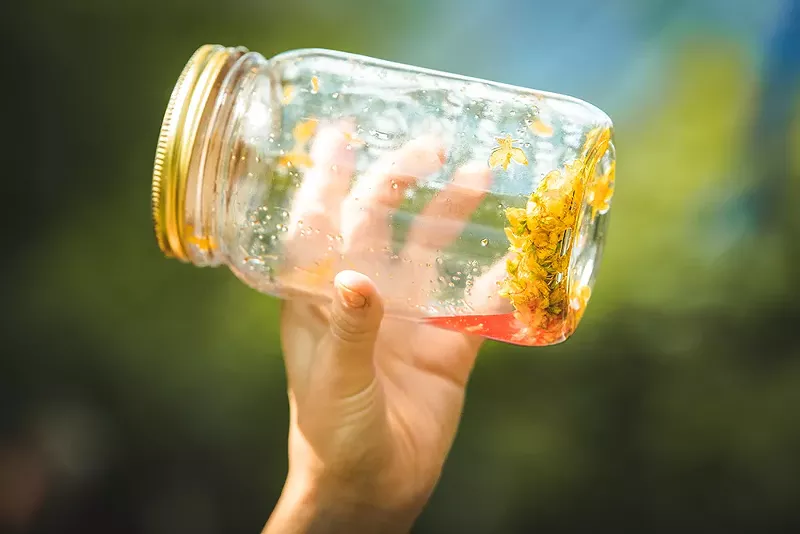
After learning how to properly identify Hypericum perforatorum, we pick the flower and commence making a tincture by steeping flowers, leaves, and stems of the plant in 100 proof vodka to extract its medicinal compounds. The tincture will be available through HWB’s community apothecary on a pay-what-you-can basis.
While Mama Ravin learned about dandelions from her grandmother, Ackerwoman’s herbalism journey started with her goal to have an orgasmic birth. That means exactly what it sounds like — having an orgasm during childbirth.
“I was pregnant with my first… and there’s this documentary called Orgasmic Birth that I got really into and I was like, how do I do that? What can I do to promote this and maybe make this happen?” she says. “I started researching more about vitamins and minerals because everyone’s always thinking prenatal vitamins are so important, so that’s when I found out more information about herbs.”
While preparing for her birth, she discovered a book by famed herbalist Susun Weed called Wise Woman Herbal for the Childbearing Year. She started drinking Weed’s herbal infusions on a daily basis to prepare for her birth.
“[The herbal infusions] have optimum vitamins and minerals and nutrition and it’s bioavailable. I had zero complications. I had a natural birth without drugs at home,” she says. “I was like, wow, and just feeling like a powerful bitch, so I kept going.”
“When you eat wild foods, you have wild thoughts and it’s truly revolutionary. Herbal medicine is the peoples’ medicine and it grows right outside your door even in the heart of the city.”
tweet this
Since then Ackerwoman has apprenticed under Weed, who is now in her late 70s, at her farm in upstate New York. Weed’s harsh teaching methods are controversial and riddled with allegations of verbal abuse. Ackerwoman describes her six-week apprenticeship with Weed as intense, but she enjoyed it so much that she’s gone back several times, including during the “Green Witch holiday” where Weed initiates apprentices as a witch.
“It was definitely one of the most life-changing experiences I’ve ever had,” Ackerwoman says. “She’s a very intense, old-school teacher. I describe it as like, the harsh tutelage of Pai Mei from Kill Bill, but with compost and herbs. I’ve done the initiation ritual a couple of times because it’s really amazing. Being in the presence of other women in ritual making commitments and having witnesses in that way is super powerful, especially for strengthening your belief in yourself.”
Ackerwoman is just getting started with HWB Detroit and has plans for future workshops that include topics like Korean Natural Farming techniques and herbs for women’s moon cycles. They also plan on working with Birth Detroit to provide herbal prenatal and postnatal support for women.
“The grow your own food movement has really taken hold in Detroit thanks to amazing organizations like Keep Growing Detroit and I want everyone to know about all the weeds that grow in between and how much nutrition and healing these wild plants have to give,” she says. “When you eat wild foods, you have wild thoughts and it’s truly revolutionary. Herbal medicine is the peoples’ medicine and it grows right outside your door, even in the heart of the city.”
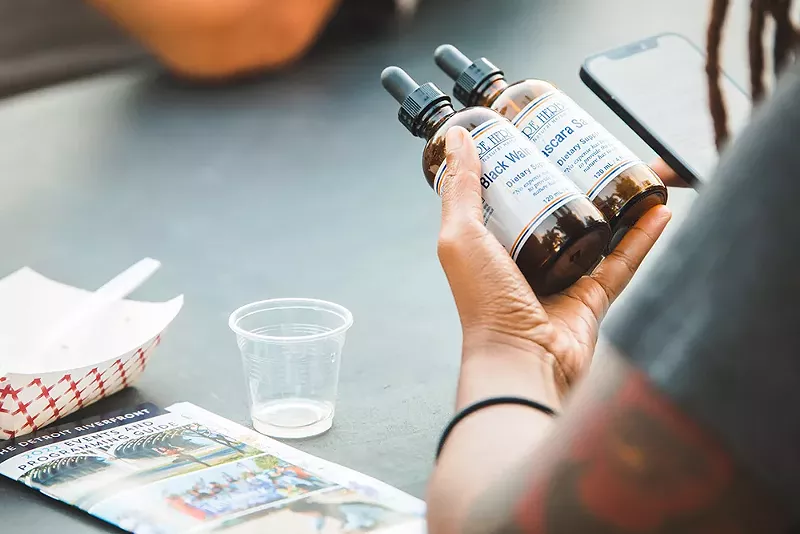
Integrative medicine
In contrast to Mama Ravin and Ackerwoman, King from Healing by Choice is an herbalist who believes in using plants with pharmaceuticals for a more well-rounded approach. She feels like a more objective voice who cautions that herbs are not a magic cure-all.
“Herbs can be powerful medicines, but it’s more about how do you create harmony in the body, not just the herbs,” she says. “It’s not like a magic cure, and learning about herbalism helped me see that complexity that the body is dynamic and so are the ways we have to think about how to heal the body. We have to think about how our sleep, and our stress levels, and environment play a role.”
Healing by Choice is a group of women and gender non-conforming people of color health and healing practitioners. They offer different healing modalities ranging from reiki, tai chi, and Chinese medicine, to energy work and herbalism.
King leads herbal workshops similar to Mama Ravin and Ackerwoman. Most recently, she hosted a workshop for Allied Media Conference which included an herb walk around Belle Isle.
“The idea was to help us get familiarized with what’s growing around us this time of year,” she says.
She acknowledges that everyone’s body is different and may not react to herbs the same.
“I try not to be prescriptive with my herbal knowledge,” she says. “It’s not as straightforward where this equals that. I’m not trying to tell people, take this and it will cure you, but there are these herbs that have been studied and tend to help with certain conditions. If someone is taking medication or has a health condition, making sure that those herbs are not contraindicated is really important too.”
King used the invasive weed stinging nettle (Urtica dioica) to help treat aggressive seasonal allergies.
“I realized the pharmaceutical treatments weren’t really working for my allergies in my 20s, so I started learning about herbs growing in fields through my friends,” she says. “Nettles were one thing that helped, but I also tried different aromatherapies, acupuncture, and even staying hydrated which I think all helped.”
King continued learning about herbalism through a six-month course with Farmacy Herbs in Rhode Island and intensives with fellow Michigan herbalist Jim McDonald. The journey helped her connect with land that felt unfamiliar as a Guatemalan woman.
“My family is half-Central American, Guatemalan, and I grew up in Southwest Detroit where many families are immigrants,” she says. “Finding a rootedness in a place where we don’t have a connection was important. Having grown up in the city in an urban area, there wasn’t really a connection to nature for me so bringing awareness of what naturally grows in Detroit was one way to deepen my sense of belonging and environmental responsibility.”
“Herbs can be powerful medicines, but it’s more about how do you create harmony in the body, not just the herbs,” Carmen Malis King says. “It’s not like a magic cure.”
tweet this
While Mama Ravin serves the vegan dinner she’s prepared to attendees at the Riverwalk, she asks who has been vaccinated against COVID-19, a loaded question since many herbalists distrust modern medicine. Ravin asserts that a blend of 13 to 26 herbs and spices that she calls “the vaccine sauce” has kept her safe.
“You’ve got basil, organic thyme, all of these things that if you eat them every day in your food are going to heal you,” she says. “That’s the vaccine right there. You need to start using everything on that spice rack.”
King understands the lack of trust in big pharma but emphasizes that pharmaceutical drugs and herbs can work together to heal the body.
“To some degree, I am distrustful of the pharmaceutical industry, but I’m vaccinated against COVID-19,” she says. “I have a masters degree in integrative health studies and I don’t think it has to be this binary thinking. It doesn’t have to be all or nothing. It doesn’t have to be herbs or pharmaceuticals. In our own grassroots way, [HBC is] trying to create a holistic path for how people are accessing wellness information.”
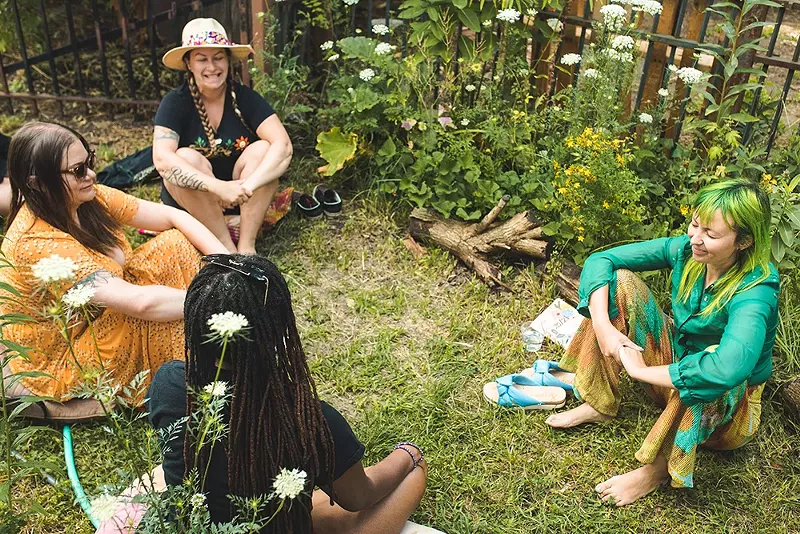
Know before you go
Knowing there are a plethora of culinary and medicinal plants growing in the wild that you can forage for free is a strange feeling. It’s intrigue, followed by a sense of freedom and frustration. Why didn’t anyone tell us we could start to heal our bodies with plants that are just outside our doorsteps instead of relying on drugs that harm us in the same swallow that they help us?
Before you get too excited and start frolicking around looking for Queen Anne’s lace, however, be aware that many plants have poisonous lookalikes that can cause some serious indigestion and even death.
Hemlock, a highly toxic plant that can be deadly if ingested, looks similar to Queen Anne’s lace. The dangerous lookalike contains toxic alkaloids that affect the nervous system and can cause respiratory collapse.
For trained herbalists like Mama Ravin, Ackerwoman, and King, the difference between Queen Anne’s lace and hemlock may be obvious. But it may not be to someone who heads out with garden shears after reading an article online.
The three herbalists have all had several years of training and experience. For beginners, King recommends getting a field guide, asking your community for guidance, and starting slow with just a few plants. There are also several smartphone apps like PictureThis and iNaturalist that can identify plants through your smartphone’s camera.
Beginner-friendly plants in Michigan include Mama Ravin’s favorite dandelion and common plantain, which have no known poisonous lookalikes. You should also be conscious of the areas you’re picking plants in to avoid environmental factors like pollution.
“Do not pick herbs that are growing in the alley, construction sites, or near the road because of potential pesticides and pollution,” Mama Ravin says. “If they’re in an open field or your backyard and you don’t spray [pesticides], they’re fair game. I tell everyone to start in their backyard.”
In addition to herb walks, classes, books, and apps, King says the most important thing is to build a physical connection to plants if you’re interested in foraging for them.
“Just sit with the plant,” she says. “If you’re curious about a plant, notice it. Where does it grow? What does it look like at different times of year? Start with that really simple sensory level. This is the most important thing. You can learn about it in a book and buy a tea with everything already mixed up, but if you never get to see the plant, I feel like there’s an element of magic that’s lost. There’s something different about seeing it, getting to touch it, harvesting it. That sensory, visual experience tops everything.”
Stay connected with Detroit Metro Times. Subscribe to our newsletters, and follow us on Google News, Apple News, Twitter, Facebook, Instagram, Reddit, or TikTok.

